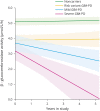β-Glucocerebrosidase activity in GBA-linked Parkinson disease: The type of mutation matters
- PMID: 32540937
- PMCID: PMC7455354
- DOI: 10.1212/WNL.0000000000009989
β-Glucocerebrosidase activity in GBA-linked Parkinson disease: The type of mutation matters
Abstract
Objective: To test the relationship between clinically relevant types of GBA mutations (none, risk variants, mild mutations, severe mutations) and β-glucocerebrosidase activity in patients with Parkinson disease (PD) in cross-sectional and longitudinal case-control studies.
Methods: A total of 481 participants from the Harvard Biomarkers Study (HBS) and the NIH Parkinson's Disease Biomarkers Program (PDBP) were analyzed, including 47 patients with PD carrying GBA variants (GBA-PD), 247 without a GBA variant (idiopathic PD), and 187 healthy controls. Longitudinal analysis comprised 195 participants with 548 longitudinal measurements over a median follow-up period of 2.0 years (interquartile range, 1-2 years).
Results: β-Glucocerebrosidase activity was low in blood of patients with GBA-PD compared to healthy controls and patients with idiopathic PD, respectively, in HBS (p < 0.001) and PDBP (p < 0.05) in multivariate analyses adjusting for age, sex, blood storage time, and batch. Enzyme activity in patients with idiopathic PD was unchanged. Innovative enzymatic quantitative trait locus (xQTL) analysis revealed a negative linear association between residual β-glucocerebrosidase activity and mutation type with p < 0.0001. For each increment in the severity of mutation type, a reduction of mean β-glucocerebrosidase activity by 0.85 μmol/L/h (95% confidence interval, -1.17, -0.54) was predicted. In a first longitudinal analysis, increasing mutation severity types were prospectively associated with steeper declines in β-glucocerebrosidase activity during a median 2 years of follow-up (p = 0.02).
Conclusions: Residual activity of the β-glucocerebrosidase enzyme measured in blood inversely correlates with clinical severity types of GBA mutations in PD. β-Glucocerebrosidase activity is a quantitative endophenotype that can be monitored noninvasively and targeted therapeutically.
© 2020 American Academy of Neurology.
Figures



References
Publication types
MeSH terms
Substances
Grants and funding
LinkOut - more resources
Full Text Sources
Medical
